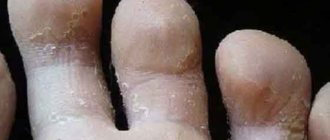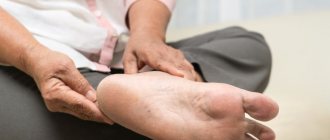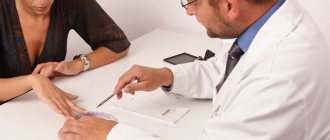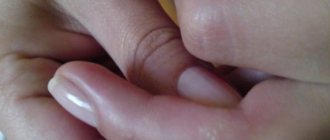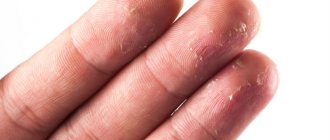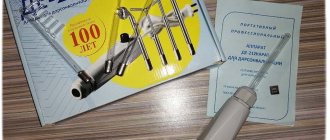According to statistics, foot skin fungus, or mycosis, affects every fifth inhabitant of our planet. This disease, although not fatal, is accompanied by very unpleasant symptoms: severe itching, peeling of the skin between the fingers, redness and an unpleasant odor. coming from the legs. It is important to start treatment in a timely manner in order to get rid of the disease at the initial stage of development. If this is not done, the disease will go into a chronic stage, and then it will be very difficult to eliminate the symptoms of skin fungus and toes.
- Baths
Why does fungus develop between the toes?
Fungus between the toes is the most common type of fungal infection, occurring in 70% of the population of our planet. This disease is especially common among people who are constantly in a humid or hot environment, often sweating due to high physical exertion. These include bath attendants, swimmers, workers in hot shops, etc. Children get sick much less often (no more than 4%), but the incidence increases sharply in adolescence.
The disease is caused by various types of dermatophilic fungi: red trichophyton, interdigital trichophyton and some types of epidermophyton. All these pathogens have a high degree of survival in the environment. They can be stored for a long time on bath and sauna floors, bath equipment, linen, and shoes.
You can become infected in a bathhouse, sauna, swimming pool, or less often on the beach. Therefore, it is so important to follow hygiene rules: use only an individual towel, do not walk barefoot in public places, using individual shoes for this.
Once on the surface of the body, fungi produce enzymes (keratinases) that decompose keratin, the protein of the surface layers of the skin. This allows the infection to penetrate the epidermis and multiply there. Fungal cell membranes contain substances (manans) that can suppress local immunity. Mananas also suppress the proliferation of superficial cells of the epidermis, which disrupts their desquamation and cleansing, which ultimately leads to a protracted and chronic course of the disease.
Factors contributing to the spread and introduction of the fungus
These factors include:
- shoes that squeeze the feet, impair blood circulation and do not allow air to pass through;
- playing sports and heavy physical labor;
- foot injuries with skin breakdown;
- immunity disorders, for example, due to diabetes mellitus, long-term use of certain medications (glucocorticoid hormones), HIV infection, etc.;
- poor circulation in the feet due to atherosclerosis of the lower extremities, flat feet, etc.
If a person has normal general and local immunity, the fungus will not be able to overcome the protective barrier of the skin and penetrate the skin. All factors that suppress skin immunity allow pathogenic fungi to freely penetrate the epidermis, causing a pathological process.
Causes
Diaper rash can be caused by several reasons:
- cardiovascular diseases;
- abrasions, wounds, cracks, scratches;
- poor-quality shoes (either squeezing the foot or out of season);
- overweight;
- work activities where you have to spend a lot of time on your feet;
- ignoring the rules of foot hygiene;
- visiting bathhouses, swimming pools, beaches without rubber slippers;
- negligent attitude towards the procedures of pedicure and manicure specialists;
- contact with a carrier of infection or the use of his shoes or clothing.
Symptoms of infection
When pathogenic fungi penetrate the skin, the areas with thin and delicate skin—the interdigital spaces—are primarily affected. This is where the infection begins, which can then spread to the entire foot. The first thing an infected person experiences is itching and burning between the toes.
Itching can be very severe, or it can be insignificant or even completely absent and appear only against the background of sweating feet or decreased immunity. Significant itching, dryness, painful cracks in the interdigital spaces contribute to the addition of a bacterial infection and the development of purulent processes.
Sometimes flaccid blisters filled with clear liquid appear between the fingers, which quickly burst open, forming erosions. And this type of disease can be complicated by the addition of a bacterial infection.
The most characteristic is the hidden course of the fungus between the toes, which is characterized by periodic itching. Often such patients are unaware of the presence of infection and spread it to others.
What to do for prevention?
If the skin between your toes becomes wet, you need to take immediate action. To prevent the development of diaper rash, experts recommend following the following rules:
- Foot hygiene. Regularly wash your feet with soapy water, treat the interdigital space with antiseptics, and dry problem areas well after water procedures.
- The right shoes. You should try to wear shoes made of natural materials with good ventilation.
- If you are prone to excessive sweating, use Teymurov's paste and ointments with zinc. The main thing is to dry the sore spots in time.
- Do not allow the disease to develop, but seek medical help if initial symptoms occur.
Always wash your feet thoroughly with soap.
Preventative measures can quickly cure diaper rash and prevent its recurrence.
Many people have sore feet. This may be a consequence of wearing tight and closed shoes, infection with a fungus, or increased activity of the sebaceous glands (hyperhidrosis). Initially, diaper rash appears as irritation and redness, but over time, cracks, ulcers, and purulent discharge form in problem areas. It is important not to delay the development of the disease and begin treatment in a timely manner.
How does the disease progress?
The fungus can manifest itself in different ways. The following forms of the disease are distinguished:
- intertriginous – the most common;
manifests itself in the form of itching and burning between the toes, dryness, cracks with the release of ichor and the subsequent development of maceration (loosening of the skin under the influence of liquid); inflammation often spreads to the plantar surface of the feet and almost never to the back; a bacterial infection is often associated; View photo. Content may be unpleasant to view. - dyshidrotic - with the appearance of flaccid, bursting blisters between the toes, the formation of erosions, the introduction of bacterial pathogens and the development of a pathological process like eczema, spreading to the entire foot, leg and even torso;
View photo. Content may be unpleasant to view. - erased - proceeds unnoticed; occasionally minor itching occurs; between the toes (most often between 1 and 2 or between 4 and 5) moderate thin peeling appears, very small cracks that go unnoticed by the patient.
Fungus in the interdigital spaces can occur as an independent disease or be a manifestation of a general infection. Often the fungus spreads to the nail plates with the development of onychomycosis. Sometimes there is a combined lesion of the skin of the feet and the skin in the area of large folds on the body, as well as the hands. In the latter case, the infection often develops according to the “two feet - one hand” principle.
How to identify an infection
The diagnosis is made based on an examination by a dermatologist and is confirmed by laboratory tests:
- microscopy method - skin elements (scales) taken from the lesion are examined under a microscope; this is the most common method, it allows you to identify a fungal infection, but cannot determine the type of fungus;
- microbiological examination - inoculation of biological material taken from the lesion on nutrient media; grown mushrooms are easy to identify, but they do not always grow in laboratory conditions, so it is often necessary to rely only on the microscopy method.
Basic principles of treatment
Antifungal drugs are used to treat interdigital fungus. If the disease does not last long and does not progress, then external remedies are used. For severe fungal infections with a tendency to spread or develop microbial eczema, antifungal drugs of general (systemic) action are used.
External use of antifungal agents requires preliminary preparation. Pathologically changed skin elements are removed from the surface of the skin: peeling, keratinized areas, remnants of burst blisters. They try to relieve inflammation and swelling of tissues as much as possible.
The following procedures are carried out:
- if there is severe inflammation and swelling of tissues, lotions with 2% solutions of boric acid and tannin, sulfur and tar ointments are prescribed; if it doesn’t help, corticosteroid ointments, for example Advantan, are prescribed in short courses;
- if scales and crusts are present, the affected areas of the body surface are lubricated with salicylic petroleum jelly twice a day, and then foot baths are performed with a 2% soda solution.
Only after cleansing is the main treatment carried out. If there is a suspicion of a mixed fungal-bacterial infection, combined ointments are used, which include antifungal, antibacterial and antiallergic components.
In what cases should you consult a doctor?
Having decided to treat the fungus at home, you should first contact a dermatologist. After carrying out diagnostic measures and determining the type of pathogen, the specialist will tell you which medications are best to use so as not to aggravate the situation.
Before using alternative medicine recipes, you also need to consult a doctor - this will help you quickly achieve the desired result without harming your health.
Important!
You will also have to visit a doctor if self-treatment does not bring any benefit. The doctor will conduct an examination and prescribe suitable, and most importantly, safe medications.
Drug therapy
The most modern drugs for the treatment of this type of disease are considered to be drugs whose active ingredient is terbinafine. Terbinafine is part of products for external use produced by various pharmaceutical companies under their own trade names. These are 1% creams, gels, sprays and solutions for external use Limisil, Terbinafine, Atifin, Exifin, Thermikon, Fungoterbin.
Terbinafine easily enters the epidermis. Already 4 hours after application to the affected areas, its concentration is sufficient to suppress the vital activity of the infection. The concentration of terbinafine accumulates in the skin gradually and after therapy is many times higher than the concentration that causes the death of fungi. At the same time, terbinafine does not penetrate into the middle and deep layers of the skin and does not have a systemic effect on the body. The peculiarity of this antifungal agent is that it also has an antibacterial effect, suppressing the activity of most pathogenic bacteria. Therefore, additional antibacterial therapy is not always required to treat fungal-bacterial infections.
Lamisil gel and spray are prescribed to treat infections accompanied by blistering and weeping. The cream of the same name is more suitable for the treatment of a disease accompanied by dryness, cracks in the interdigital spaces and severe itching.
Cream, spray and gel based on terbinafine are applied to pathologically changed areas of the feet daily for 7 days. This is usually enough for all symptoms of the infection to go away completely. If necessary, the dermatologist can extend the course of treatment.
The erased form of the disease can be treated with Lamisil for external use. Film-forming solution Lamisil Uno is also used. The drug is applied to the feet and wait until it dries. After this, it is not recommended to wash your feet for 24 hours. The full therapeutic effect is realized within a week.
Pathogens that cause fungal foot infections also show sensitivity to naftifine. It is available under the trade names Mikoderil, Exoderil (1% cream and spray), and also in the form of Mizol gel. The cream should be used daily for a month.
To treat fungal infections, 1% Clotrimazole cream with the active ingredient of the same name is also prescribed. It is applied in a thin layer to previously cleaned and dried areas of the affected skin 2-3 times a day. The course of treatment is 3 – 4 weeks.
If external treatment is ineffective and widespread, often recurrent forms of the disease, general antifungal drugs are prescribed. The doctor may prescribe one of the following medications to the patient:
- Lamisil orally after meals, 1 tablet 250 mg for 3-4 weeks;
- Diflucan (active ingredient fluconazole) orally after meals, 1 capsule 50 mg once a day for three weeks;
- Itraconazole orally after meals, 200 mg per day for a week, then 100 mg per day for 7 to 14 days.
When microbial eczema develops, complex treatment is prescribed, which includes antifungal drugs, antibiotics and desensitizing agents that reduce allergic reactions, inflammation and tissue swelling. In case of severe allergic and inflammatory processes, glucocorticoid hormones are included in the complex treatment.
In this video in the program by E. Malysheva, you can see how to prevent infection, and if it does occur, how to cure the fungus.
Folk remedies against interdigital fungus
Folk remedies can also be effective if used correctly. Traditional medicine recommends that before starting antifungal treatment, preparatory treatment is carried out to cleanse pathologically altered areas of the surface of the feet. Cleansing is carried out in the same way as before drug treatment. After this, basic means are used to suppress the activity of fungi.
- Method 1.
Twice a day for 2 - 3 weeks, make foot baths with an infusion of greater celandine (a third of a glass of crushed herb per liter of boiling water), then lubricate the dried surface of the feet with 10% propolis tincture. - Method 2.
Add 20 ml of ammonia to a glass of water, moisten the bandage, wrap first the toes, and then the entire foot (do not pull it off!) and leave until dry; Duration of treatment – 14 days. - Method 3.
Foot baths with vinegar (for 2 liters of water - 100 ml of table vinegar). Conducted daily before bed for 14 days. After the procedure, dry your feet and lightly sprinkle them with boric acid. - Method 4.
Foot baths with shag infusion (20 g shag per 1 liter of boiling water, leave for 3 - 4 hours in a thermos). Do it daily before bed for four weeks. After the procedure, your feet should dry on their own. In the morning, wash your feet with water. - Method 5.
Wash your feet with laundry soap, thoroughly rinsing between your toes. Dry your feet and lubricate the skin with celandine juice. Do this every day for 14 days. - Method 6.
Daily foot baths with 2% soda solution. After the bath, dry your feet thoroughly with a towel and lubricate them with garlic oil. In the morning, wash them with soap. Garlic butter: mix a teaspoon of crushed garlic with 100 g of butter until smooth. - Method 7.
Take equal amounts of apple cider vinegar and freshly squeezed carrot juice. Apply the resulting mixture to the affected areas of the skin of the feet several times a day for a month.
From this video you can learn everything about drug and traditional treatment of fungal infections of the feet.
Price
Prices for the most popular drug Clotrimazole 20 g vary. The table shows approximate prices and availability in Moscow pharmacies.
| Pharmacy name | A drug | Price (rubles) |
| Astra, Moscow, st. Avant-garde | Clotrimazole ointment 1% 20 g | 27 |
| Dobraya Pharmacy on Sumskaya | Clotrimazole-Acri cream 0.01 20 g | 58 |
| Vivafarm | Glaxo cream 1% | 177 |
| eapteka.ru | Teva cream 1% 30 g | 144 |
| piluli.ru | Clotrimazole quinine cream | 92 |
